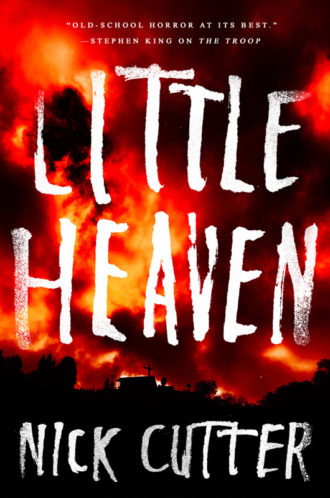 By NICK CUTTER (Gallery Books; 2017)
By NICK CUTTER (Gallery Books; 2017)
Here Nick Cutter, of the well-received horror thrillers THE TROOP and THE DEEP, tries his hand at a genre epic of the type popularized by Stephen King and Robert McCammon, with mixed results. LITTLE HEAVEN contains all of Cutter’s attributes, including solid characterizations and a facility for the grotesque that borders on genius, but it’s not a full success.
The book’s major problem is its unwieldy structure, getting into which takes some doing on the part of the reader. The narrative is very IT-like, following three mercenaries—among them a dark-skinned British gunslinger named Ebenezer, a Korean War veteran named Micah who’s been contracted to kill Ebenezer, and Minerva, a woman seeking to kill both men—through two time periods: the late 1960s, in which the three form an uneasy alliance, and the early 1980s. Both periods are dominated by a shape-shifting something loose in the deserts of New Mexico that lives to devour people and animals and then assume their forms.
The majority of the text takes place in the earlier period, with the protagonists finding themselves drawn to a settlement known as Little Heaven—one of our earliest glimpses of which involves children gleefully torturing a shrew to death. Little Heaven is home to a nutty religious cult ruled by a lunatic named Amos Flesher, who preaches a dark, apocalyptic brand of Christianity that’s fully in keeping with his demented nature. The similarities between this guy and Jim Jones are entirely intentional, as the author makes clear in a nonfiction afterward.
The shape-shifting critter is lurking nearby, and, needless to add, transforms Little Heaven into a related but more forbidding environ (one that’s not very little!). Another problem is Amos Flesher, whose madness is inflamed by the creature, and results in the Jim Jones connection becoming horrifically immediate.
The three protagonists survive the melee but, as we learn early on in the book’s 1980s section, come away having made wishes that have apparently been granted (in not-always-welcome ways). Of course we don’t discover what those wishes were, or how they were offered, until near the end of the book.
I say the whole thing is too long and overcomplicated, lacking the leanness and concentration of THE TROOP. Another problem is with the many derivative elements, such as a creepy monster kid appearing at a window and exhorting a friend to let him in (a blatant lift from SALEM’S LOT), and also the descriptions of the shape-shifter’s ever-mutating appearance (which are right out of THE THING).
On the plus side is the author’s gruesome invention, which results in some memorable gross-out set-pieces involving bloodletting, physical mutation and insects a ’plenty (example: “Eli lifted his arm. A deep hole was sunk into his flesh, all pulpy and black. Things squirmed in it. White things. Darker things”). It’s just too bad those elements are spread out over a severely protracted canvas whose bloat lessens their impact.
